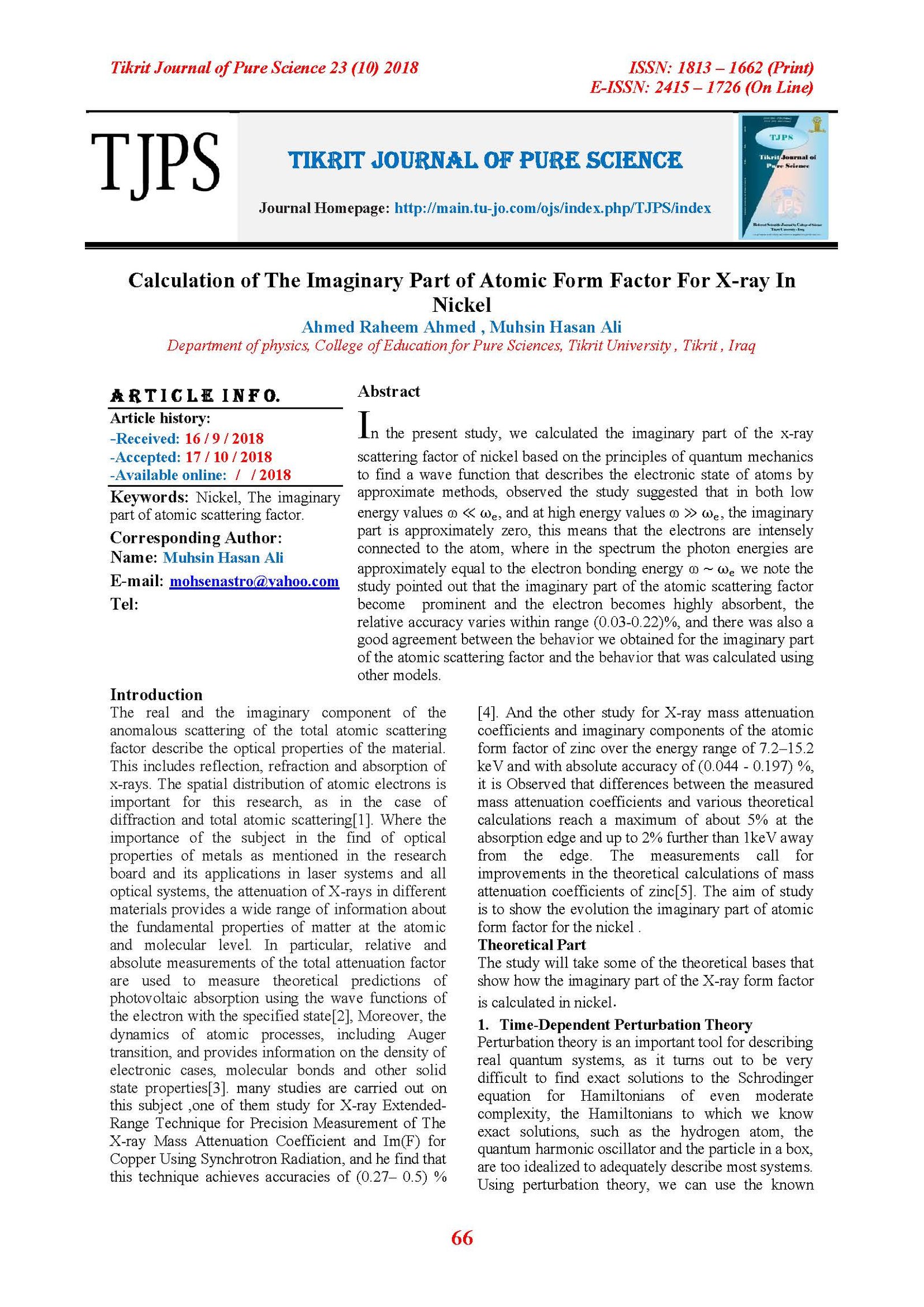Calculation of The Imaginary Part of Atomic Form Factor For X-ray In Nickel
Main Article Content
Abstract
In the present study, we calculated the imaginary part of the x-ray scattering factor of nickel based on the principles of quantum mechanics to find a wave function that describes the electronic state of atoms by approximate methods, observed the study suggested that in both low energy values , and at high energy values , the imaginary part is approximately zero, this means that the electrons are intensely connected to the atom, where in the spectrum the photon energies are approximately equal to the electron bonding energy we note the study pointed out that the imaginary part of the atomic scattering factor become prominent and the electron becomes highly absorbent, the relative accuracy varies within range (0.03-0.22)%, and there was also a good agreement between the behavior we obtained for the imaginary part of the atomic scattering factor and the behavior that was calculated using other models.
Article Details

This work is licensed under a Creative Commons Attribution 4.0 International License.
Tikrit Journal of Pure Science is licensed under the Creative Commons Attribution 4.0 International License, which allows users to copy, create extracts, abstracts, and new works from the article, alter and revise the article, and make commercial use of the article (including reuse and/or resale of the article by commercial entities), provided the user gives appropriate credit (with a link to the formal publication through the relevant DOI), provides a link to the license, indicates if changes were made, and the licensor is not represented as endorsing the use made of the work. The authors hold the copyright for their published work on the Tikrit J. Pure Sci. website, while Tikrit J. Pure Sci. is responsible for appreciate citation of their work, which is released under CC-BY-4.0, enabling the unrestricted use, distribution, and reproduction of an article in any medium, provided that the original work is properly cited.
References
[1] Krishnananda; Niranjana, K.N; Badiger, N.M.
(2013). Measurement of real and imaginary form
Factor of silver atom using a high resolution HPGe
detector. Journal of X-Ray Science and Tecgnology,
21(4) : 557-565.
[2] Islam, M. T. et al. (2014). Measurement of the Xray
mass attenuation coefficients of silver in the 5–20
keV range. Physical Review, 21: 413–423.
[3] Sidhu, B.S; Dhaliwal, A.S; Mann, K.S. and
Kahlon, K.S. (2012). Study of mass attenuation
coefficients, effective atomic numbers and electron
densities for some low Z compounds of dosimetry
interest at 59.54 keV incident photon energy. Annals
of Nuclear Energy, 42: 153–157.
[4] Chantler, C.T; Tran, C.Q; Paterson, D; Cookson,
D. and Barnea, Z. (2001). X-ray Extended-Range
Technique for Precision Measurement of The X-ray
Mass Attenuation Coefficient and Im(F) for Copper
Using Synchrotron Radiation. Physics Letters, A 286:
338–346.
[5] de Jonge, M.D; Tran, C. Q. and Hester, J. R.
(2010). X-ray mass attenuation coefficients and
imaginary components of the atomic form factor of
zinc over the energy range of 7.2–15.2 keV. Physical
Review, A 81: 022904 .
6] الشماع سالم حسن . ( 1988 ) . اساسيات ميكانيك الكم . دار ]
الكتب للطباعة والنشر ، جامعة الموصل .
[7] Griffiths, D.J. (1995). Introduction To Quantum
Mechanics . 3rd edn., new york, USA .
[8] Shankar, R. (1994). Principles of Quantum
Physics. 2nd edn., USA.
[9] Lewis, H. R; Bates, J. W. and Finn, J. M. (1996).
Time-dependent perturbation theory for the
construction of invariants of Hamiltonian systems.
Physics Letters, A 215: 160-166.
[10] Greiner, W. (1989). Quantum Mechanics An Introduction. 3rd edn., Physics and Astronomy, Springer.
[11] Simon, B.(1989). Quantum Mechanics for Hamiltonians Defined as Quadratic Form. Princeton University Press, New Jersey .
[12] Muhammad, W. and Lee, S.H. (2013). Impact of anomalous effects on the angular distribution of coherently scattered photons using Monte Carlo simulation. Acta Cryst, A69: 297–308.
[13] Rodrigues, J.B. and Cuusatis, C. (2001). Determination of X-ray Photoelectric Absorption of Ge and Si Avoiding Solid-State Effects. Nuclear Instruments and Methods in Physics Research, B 179: 325-333.
[14] Nielson, J. A. and Morrow, D.M. (2011). Elements of Modern X-ray Physics. 2nd Edn., John Wiley and Sons Ltd.
[15] Joly, Y.(2001). X-ray Absorption Near-Edge Structure Calculations Beyond The Muffin-Tin Approximation. Physical Review, B 63: 1–10
[16] Tran, C.Q; Chantler, C.T; Barnea, Z; Paterson, D. and Cookson, D.J. (2003). Measurement of the x-ray mass attenuation coefficient and the imaginary part of the form factor of silicon using synchrotron radiation. Physical Review, A 67: 1–12.
[17] Chantler, C.T. (1995). Theoretical Form Factor, Attenuation, and Scattering Tabulation for Z=1–92 from E=1–10 eV to E=0.4–1.0 MeV. physical and Chemical Reference Data, 24, 71,82.
[18] Henke, B.L; Lee, P; Tanaka, T.J; Shimambukuro, R.L. and Fujikawa, B.K. (1982). Atomic Data and Nuclear Data Tables, 27: 1–144 .
[19] Rae, N. A; Chantler, C.T. and Barnea, Z. (2010). X-ray mass attenuation coefficients and imaginary components of the atomic form factor of zinc over the energy range of 7.2–15.2 keV. Physical Review, A 81, 022904.
